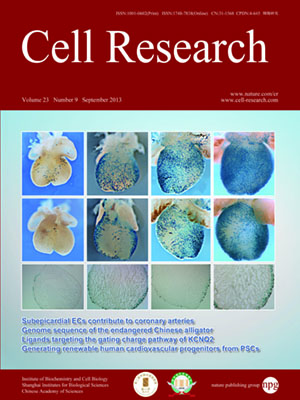
Volume 23, No 9, Sep 2013
ISSN: 1001-0602
EISSN: 1748-7838 2018
impact factor 17.848*
(Clarivate Analytics, 2019)
Volume 23 Issue 9, September 2013: 1091-1105
ORIGINAL ARTICLES
Genome analysis and signature discovery for diving and sensory properties of the endangered Chinese alligator
Qiu-Hong Wan1,*, Sheng-Kai Pan2,*, Li Hu2,*, Ying Zhu1, Peng-Wei Xu2, Jin-Quan Xia2, Hui Chen1, Gen-Yun He2, Jing He2, Xiao-Wei Ni1, Hao-Long Hou2, Sheng-Guang Liao2, Hai-Qiong Yang1, Ying Chen2, Shu-Kun Gao2, Yun-Fa Ge1, Chang-Chang Cao2, Peng-Fei Li2, Li-Ming Fang3, Li Liao2, Shu Zhang2, Meng-Zhen Wang1, Wei Dong2 and Sheng-Guo Fang1
1The Key Laboratory of Conservation Biology for Endangered Wildlife of the Ministry of Education, State Conservation Center for Gene Resources of Endangered Wildlife, College of Life Sciences, Zhejiang University, Hangzhou, Zhejiang 310058, China
2BGI-Shenzhen, Shenzhen, Guangdong 518083, China
3Changxing Yinjiabian Chinese Alligator Nature Reserve, Changxing, Zhejiang 313100, China
Correspondence: Sheng-Guo Fang(sgfanglab@zju.edu.cn)
Crocodilians are diving reptiles that can hold their breath under water for long periods of time and are crepuscular animals with excellent sensory abilities. They comprise a sister lineage of birds and have no sex chromosome. Here we report the genome sequence of the endangered Chinese alligator (Alligator sinensis) and describe its unique features. The next-generation sequencing generated 314 Gb of raw sequence, yielding a genome size of 2.3 Gb. A total of 22 200 genes were predicted in Alligator sinensis using a de novo, homology- and RNA-based combined model. The genetic basis of long-diving behavior includes duplication of the bicarbonate-binding hemoglobin gene, co-functioning of routine phosphate-binding and special bicarbonate-binding oxygen transport, and positively selected energy metabolism, ammonium bicarbonate excretion and cardiac muscle contraction. Further, we elucidated the robust Alligator sinensis sensory system, including a significantly expanded olfactory receptor repertoire, rapidly evolving nerve-related cellular components and visual perception, and positive selection of the night vision-related opsin and sound detection-associated otopetrin. We also discovered a well-developed immune system with a considerable number of lineage-specific antigen-presentation genes for adaptive immunity as well as expansion of the tripartite motif-containing C-type lectin and butyrophilin genes for innate immunity and expression of antibacterial peptides. Multifluorescence in situ hybridization showed that alligator chromosome 3, which encodes DMRT1, exhibits significant synteny with chicken chromosome Z. Finally, population history analysis indicated population admixture 0.60-1.05 million years ago, when the Qinghai-Tibetan Plateau was uplifted.
10.1038/cr.2013.104
FULL TEXT | PDF
Browse 18904


